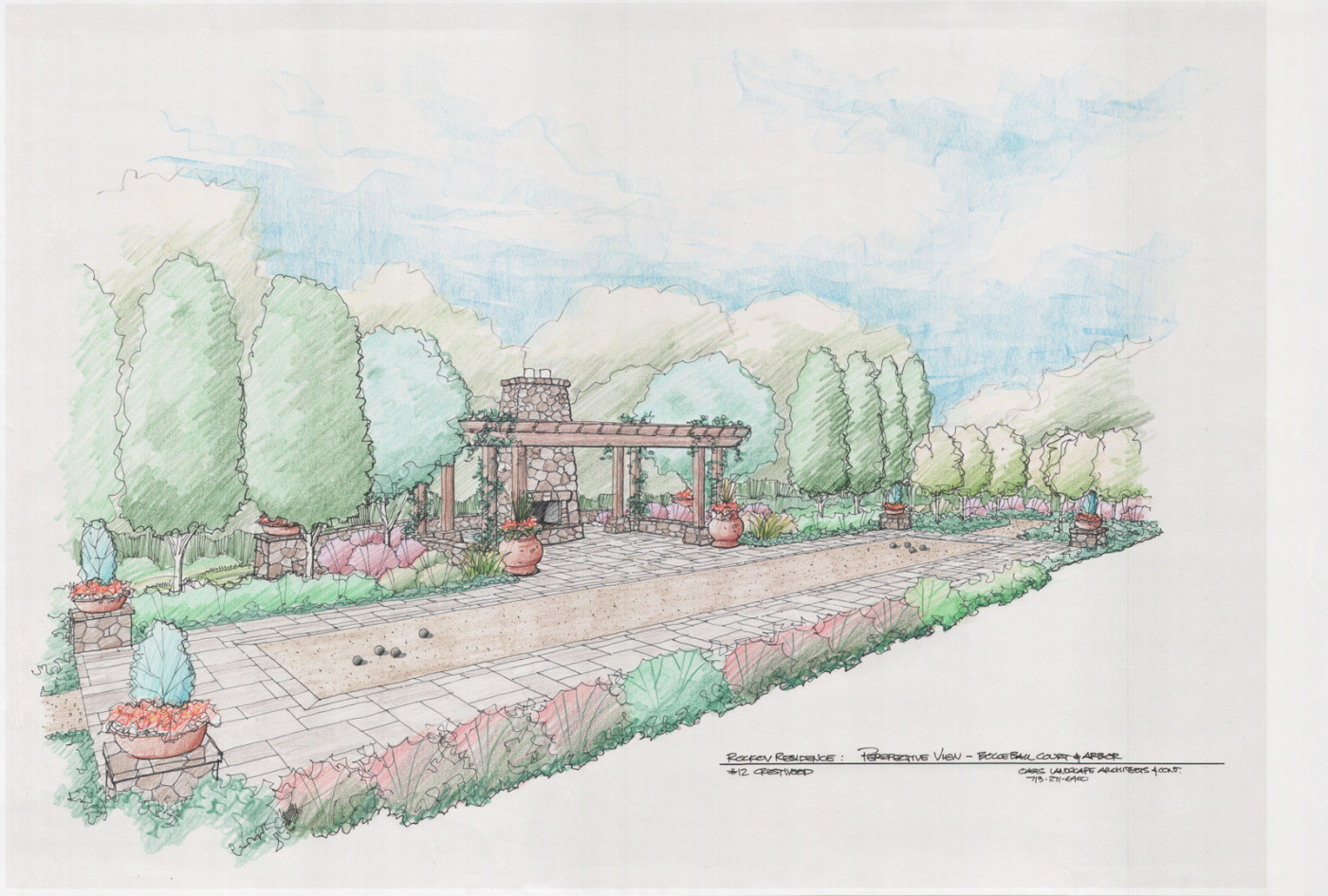Landscape Architecture for Landscape Architects › Forums › GRAPHICS › Do you feel the Landscape Industry lacks interest in 3D Visualization?
- This topic has 1 reply, 11 voices, and was last updated 11 years ago by
 Leslie B Wagle.
Leslie B Wagle.
-
AuthorPosts
-
September 5, 2014 at 2:59 pm #152486
 Dave McCorquodaleParticipant
Dave McCorquodaleParticipantI typically spend 4-5 hours on the 3D aspect of the project and I put every project in the software. By comparison I used to spend about 3-4 hours on hand rendering plans, elevations and details. I start every project with sketch paper and a pen. I work to whatever degree of detail I feel suits the project and then scan/import the sketch into the software for the 3D modeling. Once done with it I export a DXF file of the project and create the 2D plan in CAD. A typical project requires 8-12 hours of desk/computer time. The big advantage of going all digital is that revisions take a fraction of the time.
One of my professors in college who taught the CAD/software courses always stressed to us that attempting to design in CAD would always lead to inferior designs. “Throttling” the creative process through the tools available in software programs doesn’t allow the organic design process to work. Another LA in the office typically designs in Pool Studio or Microstation and it’s quite obvious the design lacks the character of a sketch.
September 6, 2014 at 2:38 am #152485 ncaParticipant
ncaParticipantWe use cintiqs
September 6, 2014 at 2:41 am #152484 ncaParticipant
ncaParticipantYou cant model in lumion and the rendering quality is marginal imo. If youre renderings are taking all night I would try to streamline your technique while youre in school.
September 8, 2014 at 5:02 pm #152483 Tosh KParticipant
Tosh KParticipantI generally respond poorly to digital trees – the texturing and leaf qualities (too much of the same) just looks bad. Our clients generally will respond to hand sketches over a poor digital drawing. I’ve usually just shot images with the base Rhino renderer, though the mapping on Vray and Maxwell work well (Maxwell softens the architecture nicely for urban models). I looked at Lumion, but the price point doesn’t justify it for our purposes – photoshop with basic SketchUp or Rhino has served us well; it usually only takes me 3~4 hrs to stick plants/people/wildlife/shadows once the base textures are in, and PS allows for softening which makes or breaks a rendering for me.
September 9, 2014 at 3:26 pm #152482 Jonathan P. Williams, RLAParticipant
Jonathan P. Williams, RLAParticipantI have found from experience that the time it takes me produce a good rendering by hand is faster than can be done in a computer 3-d program.
The clients we work with really enjoy seeing the work we put into the hand drawings. If I where to present my clients with a 3-d computer rendering chances are they would not put much value into it because they do not see the time and effort behind it.

Lastly I just enjoy drawing by hand and going home with pencil smudges on my jeans. Can’t say I would get he same satisfaction from a computer graphic.
September 9, 2014 at 5:24 pm #152481 Luke CoughlanParticipant
Luke CoughlanParticipantI rarely use Sketch Up, not because I have a problem with the program, its a great easy to use program, I’m just more of a Revit fan. I’ve been using it for a few years now and I find it’s just a more finished program with a number of great features. When I said it takes all night to render, I was referring to rendering of videos, still renders are obviously much quicker, under an hour for the most part.
September 11, 2014 at 4:59 am #152480Anonymous
InactiveFor years we have been using Sketch Up with Photoshop/Kerkythea for all our presentation work. The one thing that killed our budget is getting revisions or request for different views from our clients.
We finally found a great solution. I make models of all hardscape layouts in Sketch Up and then bring the model into Lumion where the plant materials are much better. Lumion lacks in the number of plants available, but we use “general” plants sizes and forms to get our design idea communicated.
With Lumion….any view is possible and render times are short.
September 11, 2014 at 2:31 pm #152479Anonymous
InactiveIt’s a visualization tool. It’s not real. The brain should be able to look at a well-constructed “sketch” on trace paper to get an idea of what the final product should look like. It has worked for millenia. At the end of the day, who really cares how polished a rendering is? IT’S NOT REAL!
September 12, 2014 at 8:39 am #152478 Luke CoughlanParticipant
Luke CoughlanParticipantI completely disagree, sorry to say, and here is why. Some clients have absolutely no ability to think in 3D or visualize what a design will look like in their heads, which is problematic and is of course why we do renders and sketches, amongst other reason. The fact that you say “Its not real” is looking at visualization in the wrong way. Visualization when done properly can give a client a close to real experience, or at least (And this would be in most cases) give a much clearer idea of the look and feel of the design, it just communicates better. Thanks for your input though.
September 12, 2014 at 8:46 am #152477 Luke CoughlanParticipant
Luke CoughlanParticipantWow that’s really amazing. I think being able to draw like this also comes down to a degree of natural born talent, I’m not sure how much of this you could teach, am I right in saying that? Regardless this is a perfect example of hand drawn renders that would easily sell a design. Just for interests sake, how long does something like this take you? I think for the most part something like this could actually be put up on a wall and displayed as an artwork, where as computer 3D’s tend not to be used in that way even after completion.
September 12, 2014 at 8:56 am #152476 Luke CoughlanParticipant
Luke CoughlanParticipantThat is the exact problem I ran into as well, post editing of renders on Photoshop is really time consuming. Your method is exactly what I do too, except I obviously use Revit not Sketch Up. It seems to be a much more efficient method because there is no/little need for post editing and as you stated above “any view is possible and render times are short.” I’m really hoping Lumion does extent their plant and tree library, what they already have, although limited, I feel is really effective.
September 13, 2014 at 8:32 pm #152475 Jonathan P. Williams, RLAParticipant
Jonathan P. Williams, RLAParticipantLuke it takes me about 5 hours to complete a perspective like that. From blank page to signature. I don’t know about talent. I think most all of it can be taught if the person is willing to learn. Granted everyone learns at their own pace and confidence is key.
The best way to ruin a perspective is not having confidence. Beyond that it is practice…lots of it.
September 13, 2014 at 8:34 pm #152474 Jonathan P. Williams, RLAParticipant
Jonathan P. Williams, RLAParticipantI agree it is not real at all. What really sells is your past work. Your built body of work. Walking a client through a past project that is well maintained sells more jobs than a perspective ever could.
With that said many a client will do the opposite of what you are saying and hold you to the artistic representation as being real and what it should look like in the end.
September 13, 2014 at 8:37 pm #152473 Jonathan P. Williams, RLAParticipant
Jonathan P. Williams, RLAParticipantI think this is true on some level but all this talk really should be about at what scale each time of representation is needed. If it is a larger project you are selling to a community of 1000’s then perhaps a 3d computer fly over can make it seem real. But if you are updating planting in an existing landscape or even a complete new construction 3d computer models seem over the top.
September 14, 2014 at 12:46 pm #152472 Andrew Garulay, RLAParticipant
Andrew Garulay, RLAParticipantThe question of whether the “landscape industry lacks interest” is not the same as why are not more people using it.
Several people gave their reasons why they do not use it. Each time, some people look at it as an attack on using it or a reason to set someone straight on why they should use it.
It is not a religion. There are many practical reasons that some people don’t use it and just as valid reasons that other do use it. It is a diverse field in many ways. The scale of projects are diverse. There is diversity in the end users for each of those projects within each scale. Each piece further diversifies for each variable including overall budget, design budget, project owner, what bodies need to see presentations of the project, …. it goes on and on.
But, if you look through the responses on this thread you get some answers why the use of 3D visualization is not universal.
-
AuthorPosts
- You must be logged in to reply to this topic.


